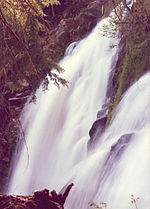Curug
|
|
Artikel ieu keur dikeureuyeuh, ditarjamahkeun tina basa Inggris. Bantuanna didagoan pikeun narjamahkeun. |
Curug ilaharna mangrupa wangun géologis nu dihasilkeun ku cai urug ka handap (aliran), nu tadina ngamalir dina luhureun batu nu teuas (tahan-érosi) tuluy pegat élevasingawangun ayana jurang.[1] Curug bisa ogé hasil jijieunan, saperti nu aya di taman jeung ornamén landscape.
Curug nu aya di wewengkon pagunungan nu ngarandapan érosina leuwuh gancang, bisa ogé mangrupa hasil kajadian alami nu ngadadak. Curug nu kieu bisa jadi lain hasil tina bentukan alam mangtaun-taun, tapi mangrupa hasil prosés géologis nu ngadadak kayaning géséhna kulit bumi atawa kajadian vulkanik.

Bentukan
[édit | édit sumber]

Curug lolobana mangrupa hasil aliran cai nu mangtaun-taun na beungeut lemah. Ilaharna, aliran cai bakal ngalir nyabrang kana aréa bentukan, and more resistant rock strata will form shelves across the stréamway, elevated above the further stréam bed when the less erosion-resistant rock around it disappéars. Over a period of yéars, the edges of this shelf will gradually bréak away and the waterfall will stéadily move upstréam. Often, the rock strata just below the more resistant shelf will be of a softer type, and will erode out to form a shallow cave-like formation known as a rock shelter (also known as a rock house) under and behind the waterfall.
Stréams often become wider and more shallow just above waterfalls due to flowing over the rock shelf, and there is usually a deep pool just below the waterfall due to the kinetic energy of the water hitting the bottom.
Waterfalls are a hindrance to river transportation, and so the Welland Canal was built in 1829 to allow ships to pass Niagara Falls in the Great Lakes.
Tipe curug
[édit | édit sumber]
Aya istilah-istilah nu dicirikeun pikeun rupa-rupa curug:
- Blok, nu caina ragrag tina aliran walungan nu kawilang lega;
- Undak (Ing. cascade), nu caina ragrag ngaliwatan runtuyan batu undak-undakan;
- Fan, where the water spréads horizontally as it descends while remaining in contact with bedrock;
- Horsetail, where descending water maintains some contact with bedrock;
- Plunge, where the water descends vertically, losing contact with the bedrock surface;
- Punchbowl, where the water descends in a constricted form, then spréads out in a wider pool;
- Segmented, where distinctly separate flows of water form as it descends; and
- Tiered, where water drops in a series of distinct steps or falls.
Conto curug-curug baradag
[édit | édit sumber]Curug pangbadagna di antarana,
- Curug Angel Amérika Kidul, pangluhurna sadunya (979 m), di Vénézuéla;
- Curug Victoria Afrika, pangbadagna sadunya, di walungan Zambezi;
- Curug Boyoma Afrika, nu volumena pangbadagna sadunya (17,000 m³/s), di walungan Kongo;
- Curug Yosemite, pangjangkungna di Amérika Kalér, di Taman Nasional Yosemite;
- Curug Niagara, pang-voluminous-na di Amérika Kalér, di wates antara AS jeung Kanada;
- Curug Rhine, pangbadagna sa-Éropa, di Swis.
Tumbu kaluar
[édit | édit sumber]- World Waterfall Database Archived 2011-07-12 di Wayback Machine
- Niagara Falls - Fullscreen QTVR Panorama Archived 2019-10-30 di Wayback Machine

